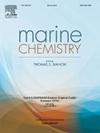河口环境中铜的氧化还原形态:对铜水化学的更好理解
IF 2.5
3区 地球科学
Q2 CHEMISTRY, MULTIDISCIPLINARY
引用次数: 0
摘要
2023年3月和7月,分别在“洁净”和“污染”两种情况下,采用固相萃取法测定了克尔卡河口分层沉积物中溶解组分中的Cu氧化还原形态,采用差分脉冲模式阳极溶出伏安法测定了Cu(I)、Cu(II)和CuT组分中的Cu。总体而言,[Cu(I)]/[CuT]在库尔卡河河口显著,变化在20.7% ~ 88.7%之间。在“干净”点E1, [Cu(I)]/[CuT]的表面最大值出现在3月份。这被认为与淡水生物群的生物活性有关,因为3月份气温上升(与前几个冬季相比),盐度较低。另一方面,在7月E1处,[Cu(I)]/[CuT]在盐跃层处达到最大值,对应于最高的生物产量,因此我们假设这是Cu(I)与生物源配体络合的结果。7月E1地表[Cu(I)]/[CuT]最小,陆生腐殖质样物质对Cu(II)的亲和力大于对Cu(I)的亲和力。在“污染点”,3月地表和盐跃层均出现E2高[Cu(I)]/[CuT]值。7月E2盐跃层[Cu(I)]/[CuT]最大,生物产量最高,7月E1盐跃层也是如此。然而,氯化物对Cu(I)的稳定作用不可忽视,在3月和7月两个站点的海水层中都保持了较高的[Cu(I)]/[CuT]。7月E2点地表[Cu(I)]/[CuT]的波动发生在白天,[Cu(I)]/[CuT]在清晨达到最小值,随后白天[Cu(I)]/[CuT]增加,说明光化学反应在Cu(I)的形成和稳定中的重要性。本文章由计算机程序翻译,如有差异,请以英文原文为准。
Redox speciation of copper in the estuarine environment: Towards better understanding of copper water chemistry
An adapted solid-phase extraction method was used for Cu redox speciation in the dissolved fraction in the stratified Krka River estuary in March and July 2023 at a “clean” and a “polluted” site, while anodic stripping voltammetry in differential pulse mode was used for Cu determination in the Cu(I), Cu(II) and CuT fractions. Overall, [Cu(I)]/[CuT] was significant in the Krka River estuary and varied between 20.7 and 88.7 %. At the “clean” site E1, the surface maximum of [Cu(I)]/[CuT] was observed in March. This was assumed to be related to the biological activity of the freshwater biota, as the temperature rose in March (compared to the previous winter months) and the salinity was low. On the other hand, at E1 in July, the maximum of [Cu(I)]/[CuT] was observed at the halocline and corresponded to the highest biological production thus we hypothesised it to be the result of Cu(I) complexation with ligands of biological origin. The minimum of [Cu(I)]/[CuT] was observed at the surface at E1 in July where terrestrial humic-like substances were present with higher affinity for Cu(II) than for Cu(I). At the “polluted site” E2 high [Cu(I)]/[CuT] values were observed at both the surface and the halocline in March. However, [Cu(I)]/[CuT] maximum was observed at the halocline at E2 in July and was associated with the highest biological production, as also observed at E1 in July. Nevertheless, the stabilisation of Cu(I) by chloride should not be disregarded as it maintained relatively high [Cu(I)]/[CuT] in the seawater layer at both stations in March and July. The fluctuations in [Cu(I)]/[CuT] occurred during the day at the surface at E2 in July, with the minimum of [Cu(I)]/[CuT] observed in the early morning, followed by an increase in [Cu(I)]/[CuT] during the day, indicating the importance of photochemical reactions in the Cu(I) formation and stabilisation.
求助全文
通过发布文献求助,成功后即可免费获取论文全文。
去求助
来源期刊

Marine Chemistry
化学-海洋学
CiteScore
6.00
自引率
3.30%
发文量
70
审稿时长
4.5 months
期刊介绍:
Marine Chemistry is an international medium for the publication of original studies and occasional reviews in the field of chemistry in the marine environment, with emphasis on the dynamic approach. The journal endeavours to cover all aspects, from chemical processes to theoretical and experimental work, and, by providing a central channel of communication, to speed the flow of information in this relatively new and rapidly expanding discipline.
 求助内容:
求助内容: 应助结果提醒方式:
应助结果提醒方式:


